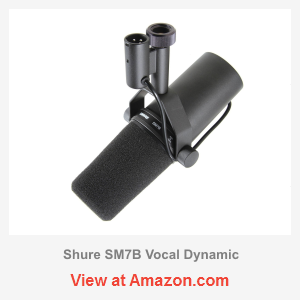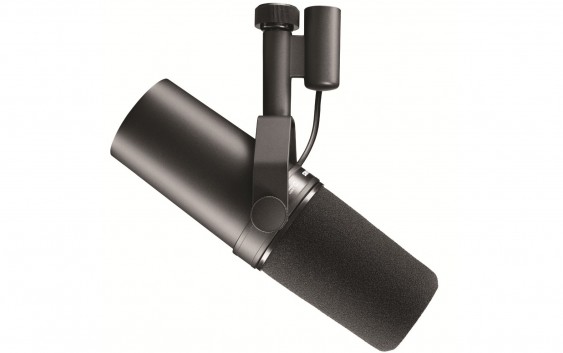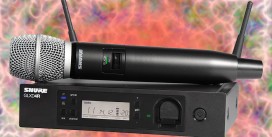Shure SM7B is a legendary high-end dynamic microphone, often used on radio stations, for podcasting, voiceovers and studio recording as well. Many people believe that to get the best sound it is somewhat mandatory to use only the expensive condensers like Neumann and similar. This microphone can easily prove them wrong. Three times cheaper than TLM 103 and 8 times cheaper than U37, it is capable of producing just as good, and in some occasions, even better results! Having its own pros and cons, it resurrects the old topic of dynamics vs condensers, but in a nutshell, the sound quality of SM7B is exceptional.
Sound & quality
Shure SM7B has a very rich, yet neutral and completely natural sounding low-end. In this respect, it is comparable to a quality bass microphone. You won’t hear any distortion or boominess of a typical consumer grade mic; it is just clean, deep and balanced bass. And this is one of the reasons why people fall in love with this microphone. No longer do you have to seek for a compromise between sounding boomy and thin, by cutting out that commonly distorted low end altogether. You’ll probably see the benefits even if you don’t have a low-pitched voice, but if you do, you’ll never trade it for anything else!
At the same time, it doesn’t sacrifice the quality of its entire frequency range. The midrange is just as neutral, with little if any coloration, but the high end is a gem. Despite the fact that there is a visible dip on the frequency diagram, the highs are exceptionally smooth and very transparent. It does have to do with the mic having a dynamic capsule, but it also has to do with the quality of the mic. To my ears, it sounds better than any flatter condenser because, because even the expensive condensers tend to have some amount of edginess, graininess or harshness but the SM7B is just completely smooth.
 There are of course the downsides of it being a dynamic. It’s not as crispy as condensers and it doesn’t offer the extended response all the way up to 20 kHz but those aren’t really cons – more like common characteristics of any dynamic. Nevertheless, its more or less flat response, all the way up to 12 kHz should be more than sufficient for any vocal applications. It has more to do with the quality of the high end rather than how high it can go. And of course, the transient response is nowhere near to condensers, so it won’t be able to capture as much of the detail, but it’s still pretty decent for a dynamic.
There are of course the downsides of it being a dynamic. It’s not as crispy as condensers and it doesn’t offer the extended response all the way up to 20 kHz but those aren’t really cons – more like common characteristics of any dynamic. Nevertheless, its more or less flat response, all the way up to 12 kHz should be more than sufficient for any vocal applications. It has more to do with the quality of the high end rather than how high it can go. And of course, the transient response is nowhere near to condensers, so it won’t be able to capture as much of the detail, but it’s still pretty decent for a dynamic.
On contrary, for applications other than studio recording, condensers are often too hot and literally capture everything. This is especially true for radio stations, because you don’t want to record every single fart of your guest. Not to mention the background noise, air-conditioning and all the possible room reflections, which are unavoidable outside the studio walls. But this is not the only reason why Shure SM7B is so popular. Unlike studio-grade condensers, this mic is also far easier to use. Therefore, it warrants for a more consistent production and leaves fewer chances for you or your guest to mess up.
Features
Shure SM7B has an internal shock mount that offers more than enough absorption, and it substitutes for those bulky external shock mounts you will usually see around Neumann’s. So even though the mic initially looks huge, it is actually much smaller than a Neumann + shock mount combo. Moreover, there is also an integrated pop filter, which in combination with the mic’s foam cover eliminates the need for external pop filters. Just imagine now the Neumann + shock mount + huge pop filter on top of that. This will completely obstruct your vision and make it impossible for an eye contact between the host and the guest, aside from other limitations.
There is of course a situation when you want to remove the foam windshield altogether and use a conventional pop filter. When recording the vocals in the studio, this is exactly what you will do. The reason is, foams muffle the high frequencies, so the mic won’t sound as bright as you’d want to in the mix. With SM7B, this is especially important, because it smoothens and softens the highs, and thus doesn’t sound as bright as condensers. However, it has an excellent feature called presence boost that compensates for its lack of brightness and gets you better results in the end. Low cut is also there, and it actually has a nice ‘n smooth transition but I didn’t find myself using it as much as high boost.
Setup
Although Shure SM7B takes best of a dynamic mic, you need to be cautious about one thing. It requires lots of clean gain (around 60 dB). In professional studios, this won’t be a problem but if you are using consumer grade mixers and preamps, make sure they have sufficient ‘horse power’. Otherwise, you may end up with noise or a very low output. To solve this, you could also place an additional preamp in the chain. For example, Cloudlifter, but this is just to give you an idea. I’ve seen many people complain that it doesn’t work with their subpar quality gear, but this isn’t the mic’s problem…
Pros
|
Cons
|










Hey I am looking to buy this mic and was wondering if you could recommended a couple condenser or preamp I could get with this mic. I’m hooking it up to the new mac book pro not sure if that makes a difference, but I’m kinda new to this and just wanna record some stuff as a hobby. Thanks for the good article.
AT ONE TIME I USED A SM7B ON EVERYTHING ONLY THE KICK DRUM DIFFERD IT WAS A EV PL20